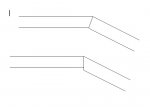Great work Max ! Looks to be very well braced.
What are the outside dimensions and weight?
And what thickness(es) are you using? ie 15mm / 18mm
I'm figuring the 12" baffle has to be 18mm ??? What's the recess routing?
Any plans to do the 60 degree also?
Thanks, Mark
What are the outside dimensions and weight?
And what thickness(es) are you using? ie 15mm / 18mm
I'm figuring the 12" baffle has to be 18mm ??? What's the recess routing?
Any plans to do the 60 degree also?
Thanks, Mark

